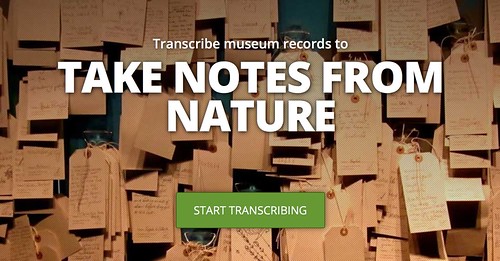Citizen Scientists Needed to Digitize Scientific Collections!
Citizen Scientists Needed to Digitize Scientific Collections!

Generally reserved for experiential projects centered around data collection or observation, citizen science offers to public a means of becoming part of the world of scientific discovery. Two unique projects offer citizen scientists a language-based means of engaging with the world of science: by transcribing field notes, journals, and specimen labels, volunteers can help make over a century’s worth of scientific information accessible to the world!
Citizen science projects offer powerful opportunities for amateur scientists of all ages to participate in meaningful scientific research. Whether for anecdotal observation-based evidence or collection of specific data, citizen science opens up the world of scientific discovery to people of all backgrounds. Generally, citizen science projects involve experiential scientific work, such as tracking bird sightings, identifying constellations, or measuring snowfall – making them ideal for science-minded folks who love to learn in a hands-on fashion.
Amongst the myriad opportunities available through citizen science projects lie two unique language-based ways of engaging with scientific topics, Notes From Nature and Smithsonian Transcription Center – both soliciting digital volunteers to transcribe field notes, journal entries, and other hand-written works so as to create digital archives of over a century’s worth of scientific information. Such projects are ideal for both science-lovers and those whose skills lie in language-based activities, and blend scientific thinking with language arts skills. Additionally, transcription-based citizen science seeks to accomplish an incredibly important goal: making decades of data and specimens to become easily accessible to researchers all over the world. Easy access to many years’ worth of data can help scientists to look at a bigger picture of changes in habitat and species populations – making transcription projects essential to gaining a deeper understanding of the changes that take place in nature over time.
Notes From Nature
Through the Notes From Nature project, citizen scientists can help to digitize information held in collections of specimens from all over the country. Composed mainly of photographs of hand-written labels and notes, the collections included in Notes From Nature are currently broken into four categories:
- MicroFungi from the New York Botanical Garden
- Ornithological from the Natural History Museum
- Herbarium from the SouthEast Network of Expertise and Collections
- Entomological from the Essig Museum collections
As items are transcribed and collections are completed, more collections can be added, thanks to the project’s connections with museums, educational institutions, and other organizations. Potential participants can choose a collection to focus on based on interests, or can transcribe bits and pieces from each of the collections to learn about each one’s contents. Citizen scientists can learn more about the project and the accomplishments achieved by digital volunteers through the Notes From Nature blog.
Smithsonian Transcription Center
Another similar project is offered through the Smithsonian, and touches not only on science, but on history and culture as well. Through the Smithsonian Transcription Center, citizen scientists can help to digitize everything from specimen labels to journals written by notable scientists that blend scientific research with everyday life experiences. In addition to science-based transcriptions, the Smithsonian’s project allows participants to delve into transcription projects related to national and international history and culture. By browsing the project’s contents, participants can choose to transcribe items based on interest, source organization, or level of difficulty.
Unlike many citizen science projects, transcription is not an activity that is accessible to all ages. While participants of most ages can learn about and learn from the material included in transcribed items, the project is best for older learners who can decipher cursive handwriting and make inferences about messy letters.
 Hilltown Families
Hilltown Families 




























